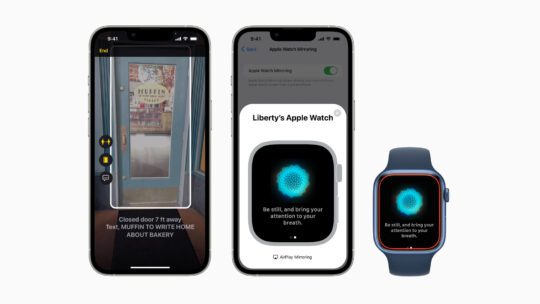
May 19 marks the annual celebration of Global Accessibility Awareness Day (GAAD). The day brings attention to the need for digital access and inclusion across communication, particularly for the more than one billion people with disabilities and impairments.
In honor of GAAD, earlier this week Apple previewed accessibility features it will roll out across its hardware and software later this year. An example is door detectability, which helps users locate a door and whether it's closed or open, according to 9to5Mac.com. Door detection also can read signs and symbols around a door, such as room numbers.
Other Apple accessibility features:
- More support for 20 languages in “VoiceOver,” the screen reader for blind and low-vision users
- Siri Pause Time, which allows users with speech disabilities to adjust how long Siri waits to respond to a request
- Live Captions for iPhone, iPad and Mac, allowing the deaf and hard-of-hearing to see captioned audio content in real-time
Keeping Communication Accessible
While Apple boosts platform accessibility through technology, PR pros also should consider making their content more accessible.
“It can’t be an afterthought anymore—accessibility needs to be ingrained in all communications,” says Alexea Veneracion, director of communications, Visit Colorado Springs. “According to the CDC, 26 percent of US adults have some type of disability,” Veneracion says.
While making content accessible is always important, it's especially so during emergencies and crises, when people need access to accurate information.
Veneracion urges holding "focus groups before launching campaigns to make sure every audience member has equal access to your content and feels accurately represented.”
Veneracion adds, "communicators should be more intentional in including those of all abilities when sourcing videographers, photographers and models to work with for campaigns.”
Accessibility Communication Tips
While it may seem intimidating to make content and communication more accessible, the resources and education are available should you commit to it. Veneraction recommends Accessible-social.com when considering social media access.
In addition, she says most social scheduling platforms (Hootsuite and Sprout Social) offer blog posts and educational materials about inclusivity and accessibility best practices.
Matisse Hamel-Nelis, VP, communications, AbleDocs, offers simple ways communicators can start making content more accessible. First, use plain language when writing.
“Using plain language helps your audience understand your content quicker and makes it easier for someone with cognitive disabilities to understand,” Hamel-Nelis says.
An example:
Complicated Language: When the process of freeing a vehicle that has been stuck results in ruts or holes, the operator will fill the rut or hole created by such activity before removing the vehicle from the immediate area.
Plain Language: If you make a hole while freeing a stuck vehicle, you must fill the hole before you drive away.
Another tip: always use alternative (Alt-Text) text and image descriptions when sharing images or graphics.
“People with low vision or sight loss will be able to better engage with your visual content when you embed alternative text into your images or graphics, while also sharing the image description in your posts on social media,” she says.
Many alt-text options can be found within content management systems (CMS). Write image descriptions into social posts.
For example, look at this image:

Alt-Text: Matisse smiles while standing in a field holding balloons.
Image Description: Matisse is smiling while standing in the middle of a field holding white, black and pink balloons. She has pink hair and is wearing a black knee-length dress and brown boots.
And always include captions.
“By adding open (embedded) or closed (non-embedded) captions, along with audio descriptions (either post-production or integrated), you make the user experience more accessible for everyone, with or without a disability,” she says.
Train the Whole Team on Accessibility
Current Global, a global communications agency, is launching in-depth training on accessible communication on May 19. Its team of accessible communication experts will host each 2.5-hour session. It's a chance for organizations with remote workers, or even in-house teams, to learn the basics of expanding accessibility communication together.
The content is based on a Feb. 2021 study of 800+ people with disabilities in the U.S. and U.K. It examined their experience accessing media and content and how brands can more effectively reach people with disabilities.
The study found most of the people struggle with accessibility. Even people who use assistive technology encounter problems. As a result, they have negative feelings and low expectations of companies and their content. MAGNA, the IPG Media Lab and Current Global completed the study.
George Coleman, Co-CEO, Current Global said the idea was initially inspired by work with Microsoft, as well as his lived experience as the child of a deaf father.
“When it comes to accessibility for the nearly 1.85 billion people living with disabilities, it’s important we embrace the fact that while tech firms are making progress, technology isn’t enough if we aren’t growing our skills and evolving the way we work as communicators," Coleman says. "My upbringing enlightened me to how communications often exclude people with disabilities by default or design, creating challenges during everyday situations. I hope this offering motivates our industry and beyond to make the commitment to producing accessible content for all.”
Current Global said it chose GAAD to launch the training because it's a day reserved to “bring more attention and awareness to digital access and inclusion to those who have disabilities and who interact daily with digital communications and technology.”
Nicole Schuman is senior editor for PRNEWS. Follow her @buffalogal
